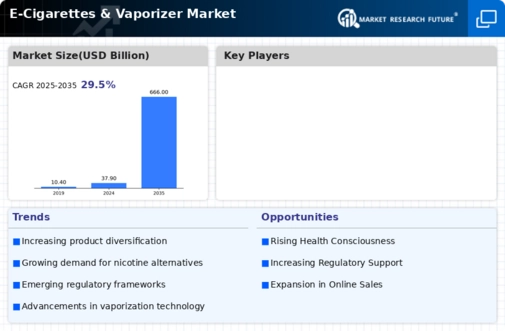Market Share
Global E-Cigarette Vaporizer Market Share Analysis
In the dynamic landscape of the E-Cigarettes & Vaporizer Market, market share positioning strategies play a pivotal role in determining the success and sustainability of industry players. With an array of brands vying for consumer attention, establishing a strong market presence is essential. One effective strategy involves product differentiation and innovation. Companies that invest in research and development to create unique and technologically advanced vaping devices, flavors, and accessories can capture consumer interest and stand out in a crowded market.
Brand image is a critical factor in determining the market share of a brand. Creating a good product name is crucial in building a brand which is trusted and reliable. Companies that value quality control, abide by the regulatory standards, and analyze the customers' needs in order to provide positive experience can make a huge difference and set themselves apart. By using marketing strategies that appeal to specific market demographics and by emphasizing product features related to lifestyle, nutrition, etc., the market share is growing.
As market in North America and Europe experience boom in the recent years due to ever-rising consciousness of the harmful effects of smoking, the demand for tobacco products have been stimulated. Quit tobacco addiction, more and more consumers actively choose the e-cigarette as a preferred alternative instead of the traditional cigarettes. This trend in consumer taste formed a major thrust for the market expansion in the North America and Europe.
Pricing strategies are the key in the market share placing in The E-Cigarettes & Vaporizer Market. Broadening the range of products in the market through providing goods for different price categories help companies target specific consumer group. While the premium products will be directed more at end-users who are enthusiasts looking for top-tier features, the lower priced options target cost-conscious consumers. In pricing strategy, the value people perceive and their price expectations should be aligned to win a wider market share.
Distribution channels and accessibility are quite important in positioning in terms of market shares. Companies that create a good balance for both online and offline shopping channels can successfully extend their distribution and appeal. Through collaborations with popular retailers, convenience stores and online platforms more markets can be exposed, and the availability can be enhanced which facilitate more market penetration.
Collaborations and joint efforts with the partners from industry also are a reason for the growth of market share. Working together with the distributors, retailers, and other related companies allows a business to leverage its synergy and extend its market reaches. Through partnerships, co-branded goods may be produced, joint initiatives may be undertaken, and resources be shared, resulting in an improved market positioning of the involved entities.
Well-tuned marketing and promotional tactics serve as the key in deciding market share. Enterprises that engage into interesting adverts on social media and team up with influencers become visible to consumers. Interactions with consumers through educational materials, testimonials, and interactive programs achieve brand awareness and consumer loyalty which positively influence market share.
Continuous monitoring of market trends and consumer preferences enables companies to stay agile and responsive. Flexibility in adapting to emerging trends, such as evolving technology, changing flavor preferences, or shifting consumer attitudes, is essential for maintaining market share. Companies that demonstrate adaptability and innovation in line with market dynamics position themselves for long-term success.



Leave a Comment